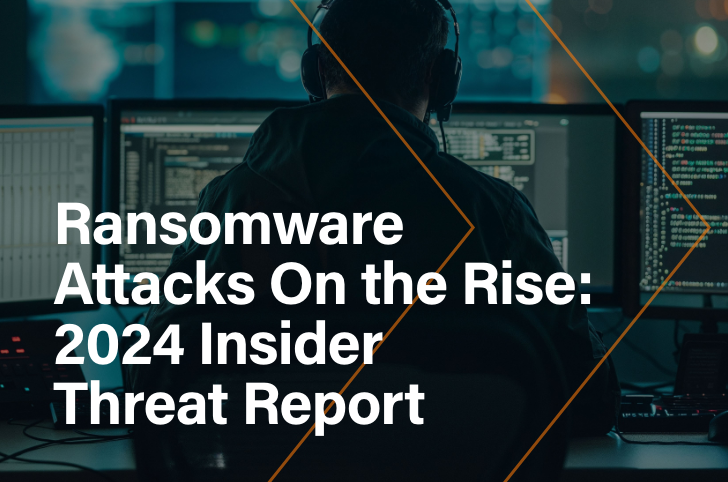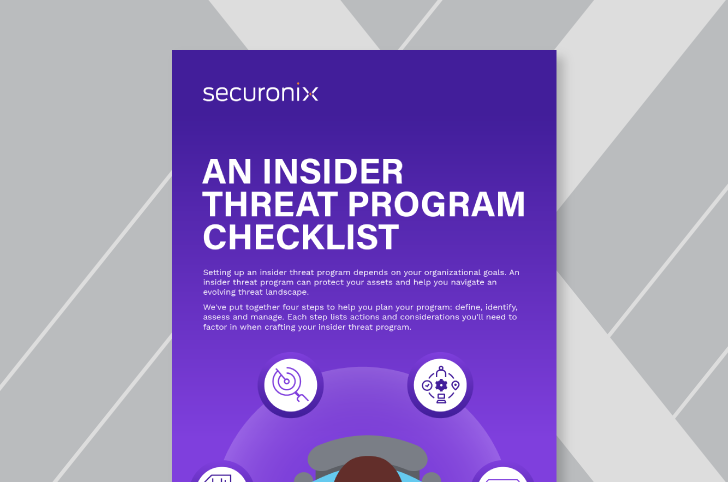- Why Securonix?
- Products
-
- Overview
- 'Bring Your Own' Deployment Models
-
- Products
-
- Solutions
-
- Monitoring the Cloud
- Cloud Security Monitoring
- Gain visibility to detect and respond to cloud threats.
- Amazon Web Services
- Achieve faster response to threats across AWS.
- Google Cloud Platform
- Improve detection and response across GCP.
- Microsoft Azure
- Expand security monitoring across Azure services.
- Microsoft 365
- Benefit from detection and response on Office 365.
-
- Featured Use Case
- Insider Threat
- Monitor and mitigate malicious and negligent users.
- NDR
- Analyze network events to detect and respond to advanced threats.
- EMR Monitoring
- Increase patient data privacy and prevent data snooping.
- MITRE ATT&CK
- Align alerts and analytics to the MITRE ATT&CK framework.
-
- Resources
- Partners
- Company
- Blog
Insider Threat
While external threats like malware attacks and network breaches grab the headlines, a significant security risk lurks from within an organization: insider threats. These threats come from authorized users, such as employees, contractors, or business partners, who misuse their access to intentionally or unintentionally harm the organization’s security posture.
At Securonix, we understand the complexities of insider threats and the critical role they play in maintaining a robust cybersecurity strategy. This blog will delve into the nature of insider threats, exploring their different forms, potential impacts, and effective mitigation strategies.
Understanding Insider Threats
An insider threat is a security risk posed by individuals with authorized access to an organization’s systems, networks, or data. These individuals can be current or former employees, contractors, vendors, or even temporary workers. Unlike external threats that originate from outside the organization, insider threats stem from individuals who are already trusted with some level of access.
The motivations behind insider threats can vary widely, ranging from malicious intent like financial gain or revenge to simple negligence through mishandling sensitive data or weak password practices. Regardless of the motivation, insider threats pose a significant challenge as they often bypass traditional security measures designed to counter external attacks.
While both external and insider threats pose risks to an organization’s security, they differ in key aspects:
- Origin
- Intent
- Detection
Recognizing and addressing insider threats is crucial for maintaining cybersecurity due to their high success rate, stemming from insiders’ authorized access and knowledge of internal systems. Failure to manage these threats can lead to significant data breaches, substantial financial losses, severe reputational damage, and potential regulatory fines, all of which compromise organizational integrity and security.
Types of Insider Threats
Insider threats vary widely but are generally categorized into three main types. Understanding these categories is crucial for implementing precise security measures to mitigate risks effectively within an organization.
Malicious Insiders
These are individuals with authorized access who intentionally misuse their privileges to cause harm to the organization. They exploit their deep knowledge of the organization’s security protocols, targeting vulnerabilities that external attackers might not be aware of. Their actions can include:
- Financial Gain
- Sabotage
- Ideological Reasons
- Espionage
This approach puts more emphasis on the category and nature of the threat while keeping the list of motivations concise and straightforward.
Negligent Insiders
These are authorized users who unintentionally compromise security through a lack of awareness or understanding of best practices. Their actions, often due to oversight or carelessness, can lead to significant security breaches. Common examples include:
- Mishandling Data
- Weak Passwords
- Clicking Phishing Links
- Poor Security Hygiene
Although unintentional, these lapses can have severe consequences, creating vulnerabilities that external attackers can exploit.
Infiltrators
Infiltrators are individuals who gain authorized access through deception or external assistance. While not technically employees, they pose a similar threat as malicious insiders upon gaining access. Common infiltration methods include:
- Social Engineering: Using manipulation tactics to trick employees into granting unauthorized access or divulging
- Piggybacking: Gaining access to a secure area by following closely behind an authorized user.
- External Compromises: Hackers might compromise a third-party vendor with access to the organization’s network, potentially allowing them to infiltrate the system.
Infiltrators are particularly dangerous because they often possess the same level of access as legitimate users, making them challenging to detect.
How Insider Threats Manifest in a Company
Insider threats can manifest in various ways within an organization. Here are some real-world examples:
- Disgruntled Employee: A recently laid-off employee deletes critical customer data out of revenge
- Financial Gain: An employee with access to financial data transfers funds to personal accounts
- Accidental Data Leak: An employee mistakenly sends sensitive information to an unauthorized recipient
- Sabotage: A contractor plants malware within the network to disrupt operations for a competitor
- Espionage: A foreign national working within the organization steals classified information for their government
These examples showcase the diverse ways insider threats can manifest, highlighting the importance of a comprehensive security strategy.
How to Combat Insider Threats
Implementing a layered approach is crucial in combating insider threats. Here are some key strategies:
- User and Entity Behavior Analytics (UEBA): Utilizes machine learning and statistical analysis to identify normal user and entity behavior patterns within a network and flag any deviations (Read more here)
- Policies and Procedures: Establish clear policies and procedures outlining acceptable data handling practices, access controls, and consequences for violations.
- Employee Training and Awareness Programs: Educate employees on recognizing and reporting suspicious activity, including social engineering tactics. Regularly conduct training sessions to keep employees informed about evolving threats.
- Data Loss Prevention (DLP) Solutions: DLP solutions can help monitor and prevent unauthorized data exfiltration attempts.
- Least Privilege Access Control: Enforce the principle of least privilege, granting users only the minimum level of access required for their job functions.
- Regular Security Assessments: Conduct regular security assessments to identify and address potential vulnerabilities within the network and user access controls.
By combining these strategies, organizations can create a more robust security posture that minimizes the risks associated with insider threats.
Future Trends in Managing Insider Threats
The insider threat landscape is continually evolving, necessitating that organizations stay proactive with emerging trends to mitigate these risks effectively. The increasing use of AI and machine learning to analyze user behavior and detect anomalies, along with more sophisticated User and Entity Behavior Analytics (UEBA), are key developments. These technologies provide deeper insights and facilitate earlier detection of potential insider threats.
As social engineering tactics grow more complex, organizations must enhance employee training to recognize and counteract these threats. With the rise of cloud adoption, developing strong security measures for cloud-based environments is also critical to protect against insider threats. Keeping abreast of these trends is essential for adapting security strategies in the dynamic digital world.
Insider threats pose a significant and evolving challenge to organizational security. By understanding the different types of insider threats, their potential impacts, and implementing a comprehensive security strategy, organizations can minimize these risks and safeguard their valuable data and assets.
At Securonix, we offer a suite of AI-Reinforced capabilities that empower organizations to detect, investigate, and respond to insider threats effectively. Our solutions leverage AI, advanced analytics and UEBA to provide actionable insights and help organizations proactively mitigate insider threats.
We invite you to explore how Securonix can transform your security posture. Check out our website, download the UEBA datasheet or Book a Demo today!






